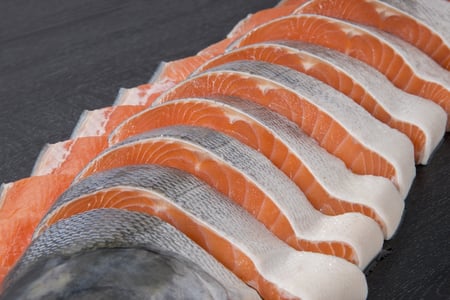
We tend to think of oxygen as a beneficial gas. Plants make it, we breathe it, it’s great — right? The problem is, oxygen is also a powerful agent in the food spoilage process.
When oxygen is the enemy, other gases are your ally in food preservation. Introducing inert gases to food packaging after vacuum sealing can keep food looking better and tasting fresher longer.
Until now, gas flushing has been available only on the most expensive models of commercial grade vacuum sealer. We wanted to put this versatile tool in the hands of more chefs, so we made Gas Flush standard on the PrimaVac™ 406 In-Chamber Vacuum Sealer.
The benefits of modified atmosphere packaging
Molds, yeasts and other microorganisms need oxygen to grow. Certain enzymes react with oxygen to speed up chemical decomposition. For example, some sliced vegetables turn brown because the enzymes catalase and peroxidase react with oxygen present in the air. And oxygen also reacts with lipids (fats) to form compounds that smell bad and taste worse, causing fish and meat to become rancid or tallowy over time.
For these reasons, vacuum packaging, which removes virtually all the air from a plastic pouch enclosing foodstuffs, can dramatically extend the shelf life of meat, fish, cheeses and other perishables (when chilled and stored properly). MAP goes one step further by introducing gases that work even harder to fight spoilage and preserve the pristine appearance of food.
The gases used for MAP depend on the type of food being packaged and the desired results.
- Carbon dioxide (CO2) when present at certain levels, can inhibit the growth of aerobic bacteria and molds.
- Nitrogen (N2) is an inert gas, meaning it rarely reacts with other substances. By excluding air, nitrogen can prevent oxidation (and the resulting rancidity) in many foods.
- Oxygen (O2) can, as we’ve said, promote oxidation and bacterial growth — but when it’s added to a other gases in set quantities, it can assist with food preservation. Oxygen can help preserve the natural red color of fresh beef, for example, or keep fruits and vegetables fresh by allowing respiration, the process by which plants turn O2 into CO2.
- Argon (Ar), like nitrogen, is an inert gas that can inhibit chemical degradation and the growth of microorganisms.
Adding gas to a vacuum-sealed pouch also prevents the compression of the food inside. MAP can preserve and protect easily crushed foods such as breads, pastries, fresh herbs and fruits. (For cushioning without preservation, use the PrimaVac™ 406 Soft Air feature.)
The question many restaurant operators ask us is: Why? In a fast-paced kitchen environment, why add one more layer of complexity to the food-prep process?
Here’s the answer: Cost savings. If your supplier offers you a great deal on baby greens, take it. MAP can preserve those delicate greens so they’re still beautiful days later. If your kitchen manager ordered too many exotic mushrooms, don’t let them rot. MAP can extend the useful shelf life of mushrooms, even truffles. Or if you operate a grocerant-style model where certain foods are packaged for retail, MAP can help reduce waste by making meat, fish and produce stay fresh and attractive for longer.
How does the Gas Flush feature work?
Gas Flush works in tandem with the vacuum-sealing cycle of the PrimaVac™ 406. Place the food in its pouch and lay it inside the chamber, with the opening on top of the seal bar. Run the vacuum cycle, which removes air from the chamber and the pouch. Then, the Gas Flush feature inserts a set volume of gas into the pouch (more gas may be desired to help cushion delicate ingredients). The pouch is sealed and the food is preserved.
The PrimaVac™ 406 gives chefs the power to fine-tune this process. A chef can adjust the length of the cycle and the volume of gas inserted. We’ve created videos and written a detailed operation manual to make this process easy to learn; our product reps and call-center experts can also walk a user through the functions. Another useful resource is the USDA Food Safety Information Office, which publishes studies on various uses of modified atmosphere packaging.
Gas Flush is only one reason to add the PrimaVac™ 406 to your kitchen. Our largest model of commercial vacuum sealer, the 406 has the capacity to seal pouches up to 16” x 20”. It features a powerful, durable JetAire™ pump, 10 custom programs and an available three-year warranty. Learn more about the PrimaVac™ commercial vacuum sealer line and vacuum sealing supplies.


